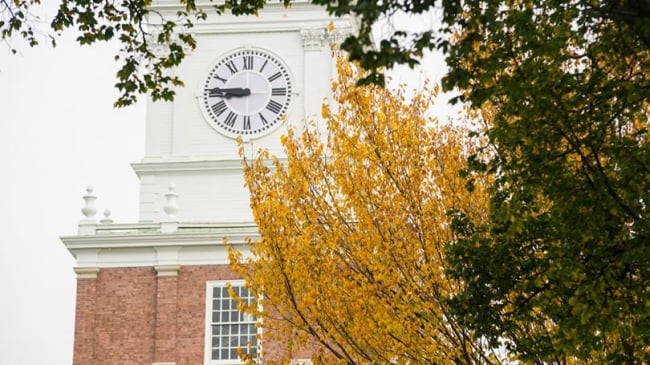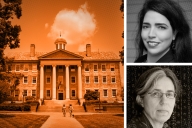You have /5 articles left.
Sign up for a free account or log in.

Dartmouth College
Dartmouth College, which fiercely defends its status as the smallest member of the Ivy League, has nonetheless started weighing the question of whether it should grow larger.
A new task force will examine the advantages and drawbacks of growing Dartmouth’s 4,310-student undergraduate body by between 10 percent and 25 percent, the college said earlier this month. The evaluation comes after President Phil Hanlon last fall named increasing enrollment as a strategic issue to be evaluated, and as the college expects a larger-than-normal cohort of first-year students arriving next month after substantially more accepted offers of admission than do so in a typical year.
The idea of significantly growing the student body could invite debate and soul-searching at Dartmouth, which clings to its identity as a historic small college with a low student-to-faculty ratio of 7.4 to one. But it comes after the college’s faculty has grown in size faster than its student body. It also comes against the backdrop of an operating budget posting a deficit of more than $100 million last year and questions over whether Dartmouth’s campus in tiny Hanover, N.H., could accommodate an influx of additional students.
Administrators say the primary impetus behind exploring growth is whether Dartmouth can serve more students without eroding its signature undergraduate experience, thereby increasing its impact. They are also quick to point out that no decision has been made on whether the college actually will grow.
“This isn’t about bringing in more revenue,” said Rick Mills, Dartmouth executive vice president. “It really is a question of, ‘Can we do more mission?’”
Yet college leaders acknowledge the idea of growth is also tied to the reality of dollars and cents. Any growth plan formed by the new task force will have to break even financially, at the very least. In other words, growth can’t run up the deficit.
Dartmouth has already been dealing with deficits in recent years. It posted an operating loss of more than $112 million in 2016, a year after an operating loss of $15.2 million. Expenses rose 3 percent to $918.1 million even as revenue slipped 2 percent to $859.7 million.
The 2016 operating losses were driven by some unique circumstances. About half, $53.5 million, came as Dartmouth restructured its school of medicine, which has been losing money in recent years. The college also had to account for noncash items like unfunded depreciation on its balance sheet and post-retiree health obligations, Mills said.
A case can also be made that Dartmouth can afford a few years of operating deficits. The university’s endowment is valued at $4.5 billion. Nonetheless, some bloggers and critics have targeted Dartmouth’s administration for lacking fiscal discipline.
Mills went on to make the case that enrolling additional undergraduates is separate from the university’s past budget deficits -- that boosting enrollment is unlikely to do more than pay for itself. Currently, the average cost of educating a student at Dartmouth is higher than what the college nets from an average student in tuition, he said. The endowment makes up the difference.
Further, Dartmouth admits citizens, eligible noncitizens and undocumented students in the U.S. on a need-blind basis, meaning it does not consider their financial situation when it offers students admission. It guarantees free tuition for students from families who have total incomes of $100,000 or less and own normal levels of assets. The college also says it guarantees students will receive all of the financial assistance necessary to meet their fully assessed need.
Of course, colleges can always construct workarounds designed to find more money from admitted students if they want to. Dartmouth is need aware for international students, meaning it takes financial need into consideration as one of many factors when deciding whether to make an admissions offer. It could conceivably raise net tuition revenue by admitting more international applicants. It could also evaluate whether students who are currently just below its admission cutoff are more likely to be full-pay students who use fewer services on campus.
That will not be the case, Mills said.
“We sort of assumed the ratio of students on aid for the cohorts that get admitted, that ratio will be the same as it is today,” he said.
The college might still find a break-even point with more students if it is able to use its facilities and serve those students more efficiently.
“How much, in growing, can you leverage your existing fixed expenses without adding to the cost base?” Mills asked. “Maybe there’s a way to grow with marginal costs that get added with the students that aren’t as large, because you don’t need a new gym, a bigger gym. You can use the same gym at the same cost.”
However, more students will likely mean more capital costs. Dartmouth would need additional residence hall beds, Mills said.
The college is already facing some pressures on its dormitory space. Dormitories that house first-year students are worn, said Andrew Samwick, a professor of economics who will be the chair this academic year of the Committee on Priorities, which forms and promotes faculty budget priorities. This year’s higher-than-expected admissions yield already means some undergraduates will be living in campus housing that was previously dedicated to graduate students, he said.
As of a May 1 commitment deadline, 61 percent of the students admitted for the Class of 2021 accepted offers, Dartmouth announced earlier this year. The college’s yield rate is typically closer to 50 percent. This fall’s enrolling class was projected to be 1,279. At the same time in 2016, 1,156 students had accepted admission for the Class of 2020.
Some melt has taken place since the May announcement, but the college still has a larger-than-normal class. The college's current enrollment for the new class is 1,222, with administrators attributing the difference from earlier projections largely to students taking gap years. Last year, 1,121 enrolled.
Consequently, Dartmouth will get a small-scale preview of what it would be like to grow the student body.
“The first thing to investigate is what having about 100 extra students in the first-year class is going to do to our educational mission to each student,” Samwick said.
Other faculty members voiced similar concerns. Dartmouth’s campus is already too small for its student body, said Thomas Cormen, a professor of computer science and former chair of the Committee on Instruction, which reviews matters related to educational policy.
Cormen likened Dartmouth’s vaunted D-Plan, a year-round quarter system devised when the college started admitting women in the 1970s, to a computer’s cache. The D-Plan -- formed amid discussion about how Dartmouth could admit women without displacing men -- rotates students off campus, enabling the college to enroll more students without adding more physical space or altering the size of the student body during any one quarter.
An upside to enrolling more undergraduates would be if the college then hired more faculty, adding to departments and intellectual activity, Cormen said. He would not support adding undergraduates without adding faculty positions.
“That would be terrible,” Cormen said. “We’d be seeing class sizes increasing. In our department, we are capping just about every course. We never used to cap courses. We don’t always hit the cap, but we have to plan for it, which is terrible.”
Computer science may be feeling the crunch of high student demand. But the number of faculty members at Dartmouth has grown faster than undergraduate enrollment over the years, said Mills, the college’s executive vice president.
Dartmouth’s School of Arts and Sciences, its largest, had 606 faculty members in 2016, according to the college’s Office of Institutional Research. That’s up by more than 15 percent from 526 in 2004.
Meanwhile, undergraduate head-count enrollment in the college was 4,310 in 2016, up only 5.7 percent from 4,079 in 2004.
Student housing issues aside, it might be possible to utilize classroom space during more hours of the day. It’s an issue to look at, one of many the task force on undergraduate expansion is charged with, Mills said.
The task force members include a college trustee and faculty members. Its two chairs, Dean of the Faculty of Arts and Sciences Elizabeth Smith and Dean of the College Rebecca Biron, were not available for interviews this week.
But Biron recently told the Associated Press that the task force will attempt to demonstrate how an increase in enrollment would be revenue neutral, potentially saving the college money in some areas and improving the quality of its undergraduate education.
“The overall question is what are the pros and cons of potential enrollment growth, and specifically, the task force has been asked to develop a hypothetical implementation plan with the idea that we would be studying the implications and impact on the educational experience here if we pursued growth in the student body,” said Biron, who is a professor of Spanish and comparative literature. As dean of the college, she is Dartmouth’s senior officer responsible for undergraduate academic life.
Faculty members are also concerned the newly formed committee is expressly charged with examining growing undergraduate enrollment. Reducing undergraduate enrollment could also be looked at, said Samwick, who is chairing the Committee on Priorities. He expects the idea to come up in discussions in the future.
“The challenge for Dartmouth is to be the best of both worlds: a research university that competes with much larger peers but devotes the bulk of the expertise of the faculty to the teaching of undergraduate students,” Samwick said. “I think that’s a unique value proposition that we offer to students.”
The task force is slated to draw up an initial report for Mills and other Dartmouth administrators by the end of October. A final report is due in the middle of March.
Dartmouth says the effort comes as several of the college’s departments seek more students from upcoming classes. Some have also asked for more students from different backgrounds, students with different interests and students from other countries.
The college has also stressed that other Ivy League institutions have been growing faster than it has.
Dartmouth’s ability to convince students, faculty and alumni that it will remain a small college will likely be key to the success or failure of any plan to enroll more undergraduates. Dartmouth’s identity is closely tied to the idea of smallness. A favorite story from its history is that of Dartmouth College v. Woodward, an 1819 Supreme Court case considered key to U.S. contract and corporate law.
Daniel Webster, an alumnus who would later go on to become a U.S. senator, represented Dartmouth. He made an emotional plea for Dartmouth, saying it was a small college, “and yet there are those who love it.”
The college’s size might not have been the immediate issue that the court decided -- that issue was whether the state of New Hampshire could turn Dartmouth into a public university. But the idea of Dartmouth as a small college has endured.
It was brought up by alumni discussing the task force on expansion in the Dartmouth College Class of 1983 Facebook group. One commenter said, “Daniel Webster is rolling over in his grave.” Another said that “doubling in size will change the whole experience and culture that is Dartmouth.” (The maximum growth that the committee is considering, however, is 25 percent.)
Some credited Dartmouth for forming a task force and having an open discussion before making a decision, though. One commenter said that “a college that doesn’t at least consider … multiple paths to sustainability and relevancy lives in the past.”








